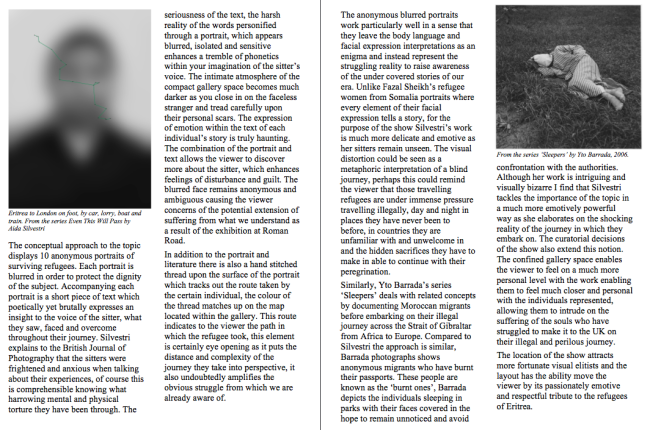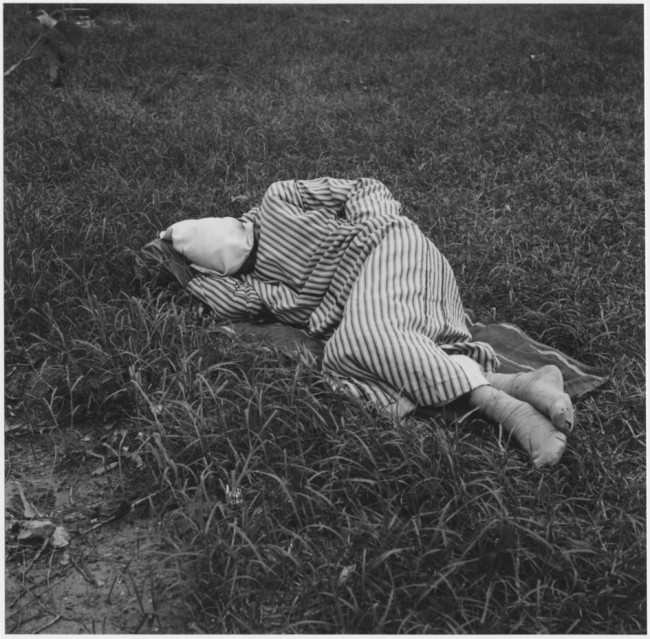Unit Title: Visual Exploration
Unit Code: VPF409
Level: 4
Assessment Title: Illustrated Exhibition Review
Assessment Number: AE1
Assessment Type: Exhibition Review
‘A section of the assessed review layout.’
A Voice for Eritreans
‘Even This Will Pass’ by Aida Silvestri.
Roman Road, London.
11th March to 26th April 2014.
Exhibition Review by Danielle Pugh
Aida Silvestri, embarks on a thin-skinned photographic voyage exploring the journey made by African refugees from Eritrea to Europe in a desperate attempt for stability and equality within the promise land. The show is exhibited from 11/3/14 – 26/04/14 at the Roman Road Project Space in London, Bethnal Green.
It’s well known yet often overlooked that the Horn of Africa struggles from economic and political crisis. While ruled by a dictatorial government the population of Eritrea are without freedom of speech as well as being under a political regime known as the ‘North Korea of Africa’. These circumstances result in violent conflict over the pursuit of power. As well as drought, famine and many other demoralising aspects, this has resulted in high numbers of African refugees fleeing their countries in hope for a better life elsewhere.
Silvestri’s series at Roman Road documents the overlooked, tragic and shocking stories of the journeys refugees embark on from Eritrea. The elements of the show create a tense and overwhelming atmosphere of shock and severe empathy.
The initial intention of the show is to raise awareness of the horrific consequences refugees face when pursuing to escaping from their past lives in Africa. Many of them regretfully end up at prison camps, in the hands of human traffickers, being tortured, abused, or even departing from life altogether. What some of us fail to see is that it is ultimately unfair that whilst we have no control over where we are born, depending on where that may be some of us are restricted to whether we can leave in order to enhance our lives, therefore in severe cases are force to face life threatening sacrifices in order to do so.
The title of the show ‘Even This Will Pass’ comes from a message written upon a wall in Mount Sinai, the message encourages Eritreans to stay persistent and keep hope as they pass through Egypt whilst making their way to the United Kingdom, known as the promise land.
Eritrea to London on foot, by car, lorry, boat and train. From the series Even This Will Pass by Aida Silvestri
The conceptual approach to the topic displays 10 anonymous portraits of surviving refugees. Each portrait is blurred in order to protect the dignity of the subject. Accompanying each portrait is a short piece of text which poetically yet brutally expresses an insight to the voice of the sitter, what they saw, faced and overcome throughout their journey. Silvestri explains to the British Journal of Photography that the sitters were frightened and anxious when talking about their experiences, of course this is comprehensible knowing what harrowing mental and physical torture they have been through. The seriousness of the text, the harsh reality of the words personified through a portrait, which appears blurred, isolated and sensitive enhances a tremble of phonetics within your imagination of the sitter’s voice. The intimate atmosphere of the compact gallery space becomes much darker as you close in on the faceless stranger and tread carefully upon their personal scars. The expression of emotion within the text of each individual’s story is truly haunting. The combination of the portrait and text allows the viewer to discover more about the sitter, which enhances feelings of disturbance and guilt. The blurred face remains anonymous and ambiguous causing the viewer concerns of the potential extension of suffering from what we understand as a result of the exhibition at Roman Road.
In addition to the portrait and literature there is also a hand stitched thread upon the surface of the portrait which tracks out the route taken by the certain individual, the colour of the thread matches up on the map located within the gallery. This route indicates to the viewer the path in which the refugee took, this element is certainly eye opening as it puts the distance and complexity of the journey they take into perspective, it also undoubtedly amplifies the obvious struggle from which we are already aware of.
The anonymous blurred portraits work particularly well in a sense that they leave the body language and facial expression interpretations as an enigma and instead represent the struggling reality to raise awareness of the under covered stories of our era. Unlike Fazal Sheikh’s refugee women from Somalia portraits where every element of their facial expression tells a story, for the purpose of the show Silvestri’s work is much more delicate and emotive as her sitters remain unseen. The visual distortion could be seen as a metaphoric interpretation of a blind journey, perhaps this could remind the viewer that those travelling refugees are under immense pressure travelling illegally, day and night in places they have never been to before, in countries they are unfamiliar with and unwelcome in and the hidden sacrifices they have to make in able to continue with their peregrination.
From the series ‘Sleepers’ by Yto Barrada, 2006.
Similarly, Yto Barrada’s series ‘Sleepers’ deals with related concepts by documenting Moroccan migrants before embarking on their illegal journey across the Strait of Gibraltar from Africa to Europe. Compared to Silvestri the approach is similar, Barrada photographs shows anonymous migrants who have burnt their passports. These people are known as the ‘burnt ones’, Barrada depicts the individuals sleeping in parks with their faces covered in the hope to remain unnoticed and avoid confrontation with the authorities. Although her work is intriguing and visually bizarre I find that Silvestri tackles the importance of the topic in a much more emotively powerful way as she elaborates on the shocking reality of the journey in which they embark on. The curatorial decisions of the show also extend this notion. The confined gallery space enables the viewer to feel on a much more personal level with the work enabling them to feel much closer and personal with the individuals represented, allowing them to intrude on the suffering of the souls who have struggled to make it to the UK on their illegal and perilous journey.
The location of the show attracts more fortunate visual elitists and the layout has the ability move the viewer by its passionately emotive and respectful tribute to the refugees of Eritrea.
Silvestri intention to give a voice to those who are commonly unheard has certainly been granted and with full optimism the show can continue to raise awareness of human trafficking and other relentless excruciating situations refugees are confronted with while simply trying to enhance their lives.
Bibliography
Books –
Maxted, J, and Abebe, Z, 2001. Human Stability and Conflict in the Horn of Africa. Volume 10, Issue 4, 2001. South Africa. p45-57
Bariagaber, A., 2006. Conflict and the refugee experience: flight, exile, and repatriation in the Horn of Africa. Aldershot: Ashgate.
p. Preface, ix. Part I, 1 p2 and 2 p21, Part II, 3 p41.
Journals –
Padley, G, 2013, Aida Silvestri’s Even This Will Pass. British Journal of Photography. [online] Available from:
http://www.bjp-online.com/2013/07/aida-silvestris-even-this-will-pass/
Padley, G, 2014, Aida Silvestri puts on solo show. British Journal of Photography. [online] Available from:
http://www.bjp-online.com/2014/03/aida-silvestri-solo-show/
Article –
Hagen, C, 1996. Photography Review: Reading the Sorrow of Africa in Individual Faces. The New York Times. MLA 7th Edition. [viewed 19 April 2014]. Available from:
Websites –
Ballani, M., 2014, Roman Road, Aida Silvestri, Even This Will Pass, Press Release. [online] [viewed 17 March 2014]. Available from:
http://www.romanroad.com/wp-content/uploads/2014/02/PR_ASRRLSHOW14.pdf
UNHCR Global Appeal, 2014. East and Horn of Africa UNHCR Regional operations profile. [online] [viewed 20 April 2014] Available from:
http://www.unhcr.org/pages/49e45a846.html
UNHCR The UN Refugee Agency, 2014. Regional Overview. [online] [viewed 20 April 2014] Available from:
http://data.unhcr.org/horn-of-africa/regional.php
BBC News, Africa, 2011. Horn of Africa drought: Kenya row over Somali refugees. [online] [viewed 20 April 2014] Available from:
http://www.bbc.co.uk/news/world-africa-14144893
Scottish Refugee Council, Real Lives. [online] [viewed 20 April 2014] Available from:
http://www.scottishrefugeecouncil.org.uk/about/refugee_stories
Art Fund, Photographs from the series ‘Sleepers’ by Yto Barrada, 2009. [online] [viewed 20 April 2014] Available from:
http://www.artfund.org/what-we-do/art-weve-helped-buy/artwork/10550/%5Bobject%20Object%5D
A Camel for the Son, Fazal Sheikh, Description. [online] [viewed 10 April 2014] Available from:
http://www.fazalsheikh.org/projects/a_camel_for_the_son/description.php
Autograph ABP, Exhibitions, Aida Silvestri, Even This Will Pass, 2014. [online] [viewed 21 April 2014] Available from:
http://autograph-abp.co.uk/exhibitions/even-this-will-pass
Sherwin, S., 2011. Artist of the week 169: Yto Barrada. [online] [viewed 20 April 2014] Available from:
http://www.theguardian.com/artanddesign/2011/dec/22/artist-week-yto-barrada


